Gesture Control Light Market Research, 2032
The global gesture control light market size was valued at $377.6 million in 2022, and is projected to reach $645.7 million by 2032, growing at a CAGR of 5.6% from 2023 to 2032.
The gesture control system evaluates the gesture after it has been detected and converts it into a specific command or action for the lights. For instance, a wave gesture turns on or off the lights, while a swipe motion could change the brightness or color temperature. Some gesture control lights respond to the user's motions with visual or tactile feedback to let them know their intended action was carried out. LED indicators, auditory cues, or other interactive components are used as this feedback.
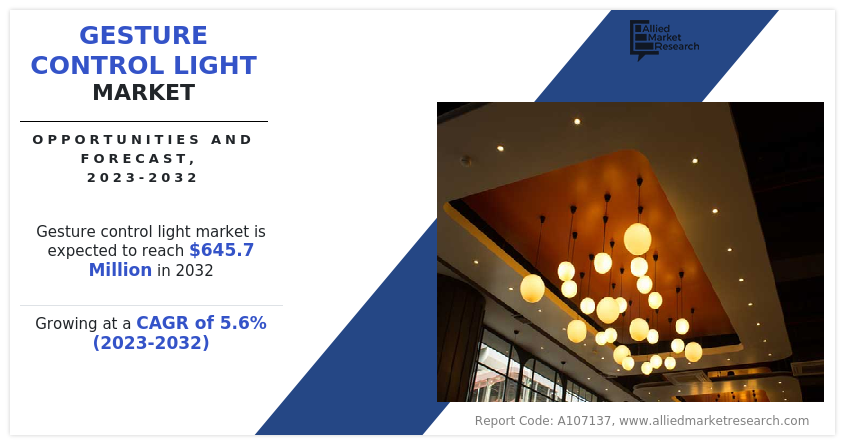
MARKET DYNAMICS
The dynamics of the gesture control light market are significantly influenced by developments in sensor technology, connectivity, and gesture recognition. The adoption of gesture control lights is driven by advancements in precision, responsiveness, and compatibility with many platforms and devices. The market dynamics are influenced by consumer demand and preferences for simple and intuitive control of lighting systems. The gesture control light market is anticipated to rise as customers become more aware of gesture control technology and its advantages.
The accuracy with which gestures are recognized is one of the major limitations. Although there have been tremendous improvements, user motions are still not always detected and understood by gesture control systems. Accurate recognition is crucial for smooth lighting system control because inaccurate recognition can be frustrating. Users must become familiar with specific gestures and the purposes they serve in order to use gesture control. Some users could find this learning curve to be a hurdle, particularly those who are less tech-savvy or are not comfortable with gesture-based interactions. The necessity for user adaptation has an impact on how widely gesture control lights are used.
An important gesture control light market driver is the incorporation of gesture control lighting into smart home ecosystems and IoT platforms. The demand for gesture control lights as a component of the ecosystem is projected to increase as more homes adopt smart home technologies and seek seamless management over their lighting systems. The market dynamics for gesture control lights are being driven by the emphasis on energy efficiency and sustainability. Due to the increased need for environmentally friendly solutions, these lights provide the possibility for energy savings by allowing users to control illumination more effectively and selectively.
For efficient operation, gesture control lights frequently need a certain range and a clear line of sight. Users must be in a certain area or have enough room for their gestures to be accurately recognized. The usability of gesture control lights is constrained by their restricted gesture range and space requirements, which makes them unsuitable for some contexts or individuals with limited mobility. The effectiveness of gesture control lighting is influenced by environmental conditions and ambient light. The accuracy of gesture recognition is compromised by direct sunshine, dimly lit spaces, or interference from other light sources. The ability to use gesture control lights in some situations is constrained by their reliance on ideal lighting conditions.
Pricing is essential to understanding gesture control light industry dynamics. Consumer adoption rates of gesture control lighting are influenced by their price. More accessible options spur market expansion and enlarge the consumer base as technology improves and production prices fall. The market dynamics for gesture control lighting are influenced by regulations and industry standards. The product options and gesture control light market competitiveness are influenced by adherence to safety standards, interoperability requirements, and laws governing wireless communication and electromagnetic interference.
The underlying technology, which includes sensors, algorithms, and networking, is what powers gesture control lighting. The functionality and dependability of gesture control systems are affected by technical difficulties, software incompatibilities, or disruptions in the technology infrastructure. This reliance on technology raises the possibility of a barrier to smooth and reliable operation. Although there are affordable gesture control lights, for some consumers the entire cost of gesture control systems remains a barrier. Price-sensitive markets and consumers with limited funds find it difficult to afford advanced gesture control technologies and premium features.
A simple and hands-free method of controlling lighting systems is provided by gesture control lights. Users who want to quickly change lighting levels, colors, or ambiances without using switches or complicated interfaces appreciate this simplicity. The chance is in offering smooth and simple control experiences that improve user ease. There are prospects for compatibility with other smart systems and devices when gesture control lights are included in larger smart home ecosystems. Users now control their lighting alongside other connected devices like voice assistants, motion detectors, or home automation hubs due to this connection. The opportunity is in establishing a coordinated and synchronized smart home setting that reacts to gesture commands.
SEGMENTAL OVERVIEW
The global gesture control light market is analyzed on the basis of price range, application, distribution channel, and region. By price range, the market is divided into economy and premium. As per application, the market is bifurcated into residential and commercial. Depending on distribution channel, it is classified into supermarkets/hypermarkets, specialty electronic stores, online sales channel, and others. Region wise, the market is analyzed across North America (the U.S., Canada, and Mexico), Europe (the UK, France, Germany, Italy, Spain, and the rest of Europe), Asia-Pacific (China, India, Japan, South Korea, Australia, and the rest of Asia-Pacific), and LAMEA (Brazil, Argentina, South Africa, Saudi Arabia, United Arab Emirates, and the rest of LAMEA).
BY PRICE RANGE
As per price range, the economy segment dominated the global gesture control light market in 2022 and is anticipated to maintain its dominance throughout the forecast period. Focusing on cost-cutting is one of the main trends for economy gesture control lights. To reduce manufacturing costs, manufacturers will work to simplify supply chains, use cost-effective components, and optimize production methods. As a result, more consumers will be able to buy gesture control lighting. To cut production costs, economy gesture control lights have simpler designs. This entails using fewer sensors or parts, using simpler gesture recognition algorithms, and emphasizing essential functionality over more complex features. Striking a balance between price and necessary functionality is the goal.
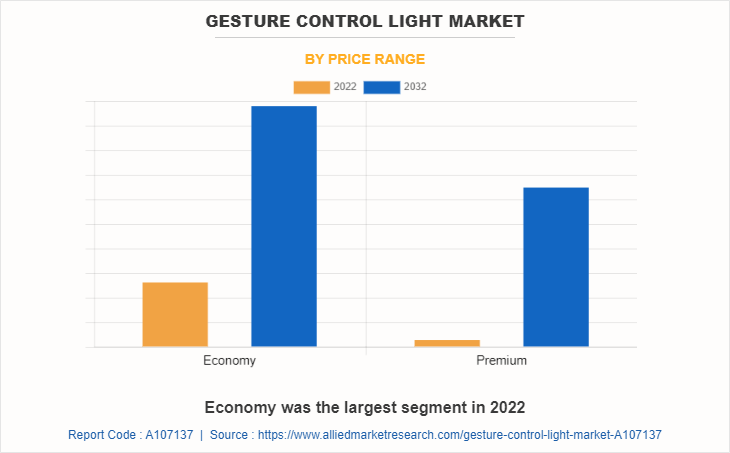
BY APPLICATION
The residential segment dominated the global gesture control light market in 2022. In order to manage lighting efficiently, gesture control lights are used in workspaces. To turn lights on or off, modify brightness levels, or activate particular lighting settings, employees use gestures. In order to automatically adjust illumination based on workplace occupancy, the gesture controlled technology is also integrated with occupancy sensors. In conference rooms and presentation areas, gesture control lights are used to offer seamless lighting management during meetings, presentations, and events. Presenters utilize gestures to change the lighting for various circumstances, draw attention to particular places, or reduce the lights.
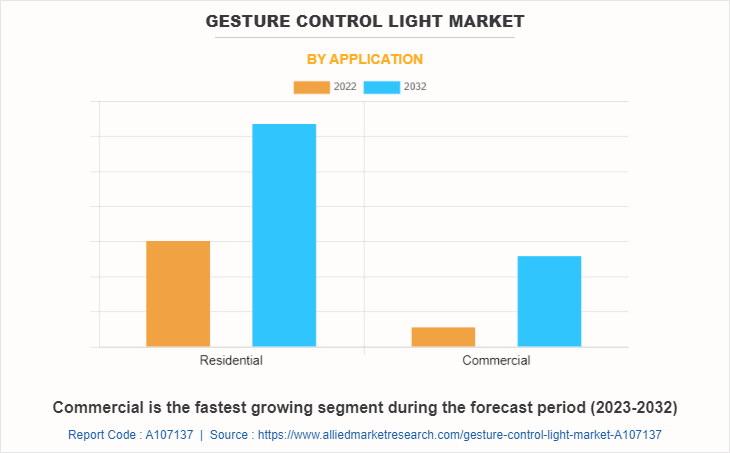
BY DISTRIBUTION CHANNEL
The online sales channel segment is predicted to show the fastest gesture control light market growth during the forecast period (2023-2032). Customer convenience and accessibility are provided through online sales platforms. Using their laptops or mobile devices, they browse and buy gesture control lights whenever and wherever they choose. Customers make informed purchases whenever it is convenient for them because of the availability of 24/7 information. Online sales platforms allow businesses to offer thorough product information, such as specifications, features, photos, and customer reviews. Informed choices are made and a sense of trust in the suitability and quality of the product is fostered in this way by potential customers.
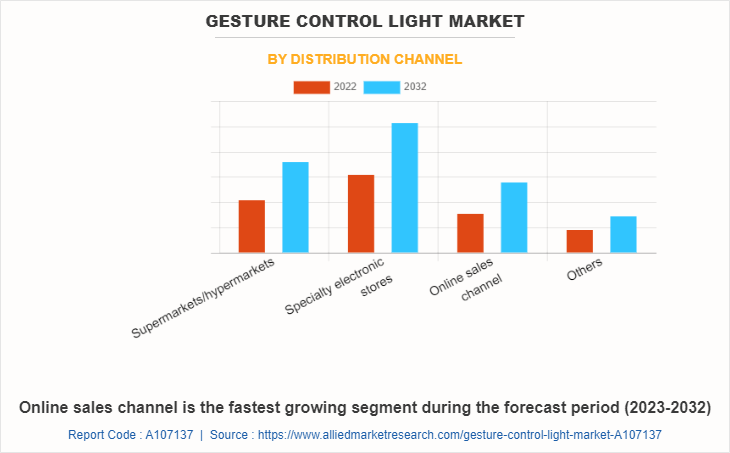
BY REGION
Region wise, Asia-Pacific is predicted to dominate the market with the largest gesture control light market share during the gesture control light market forecast period (2023-2032). The convenience of gesture control lights and greater customer knowledge of the advantages of smart home technologies have helped the industry expand. There is a growing gesture control light market demand as consumers look for methods to improve the look of their living spaces with contemporary lighting solutions. Intense competition between domestic and foreign competitors defines the gesture control light market in the Asia-Pacific region. To meet the expanding demand, well-known lighting manufacturers, tech businesses, and start-ups are all actively creating and marketing gesture control light products.
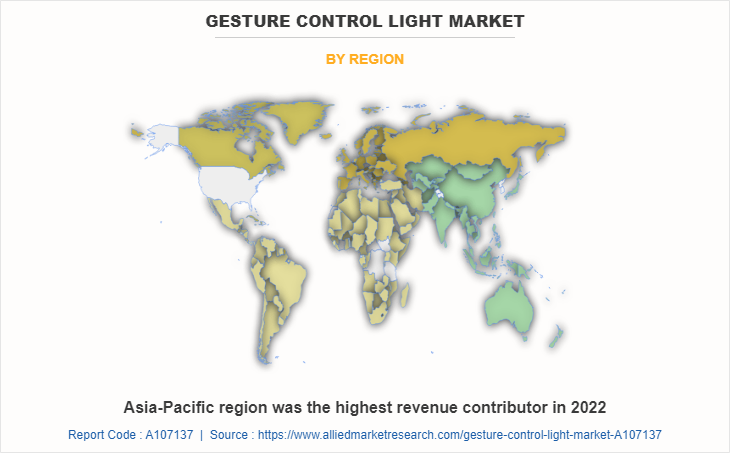
COMPETITION ANALYSIS
The dynamics of the gesture control light market are greatly influenced by the level of competition and the existence of key players in the sector. The development of novel gesture control light products, user experiences, and market share are competitive goals for established lighting companies, technology manufacturers, and startups.
The major players analyzed for the gesture control light industry are Allocacoc, Banvil 2000, Fibar Group S.A., iGear Tech Pvt. Ltd., Neona Living GmbH, Nimbus Group GmbH, Occhio GmbH, Otus, The Tactigon, Yeslights. Market dynamics are influenced by effective marketing tactics, product positioning, and promotion. Companies that effectively convey the advantages, practicality, and value proposition of gesture control lights stimulate interest and increase demand. The dynamics of the market are influenced by partnerships between technology suppliers, gesture control light manufacturers, and other industry stakeholders. Partnerships foster innovation, widen distribution channels, and forge synergies that respond to changing consumer demands.
Key Benefits For Stakeholders
- This report provides a quantitative analysis of the market segments, current trends, estimations, and dynamics of the gesture control light market analysis from 2022 to 2032 to identify the prevailing gesture control light market opportunities.
- The market research is offered along with information related to key drivers, restraints, and opportunities.
- Porter's five forces analysis highlights the potency of buyers and suppliers to enable stakeholders make profit-oriented business decisions and strengthen their supplier-buyer network.
- In-depth analysis of the gesture control light market segmentation assists to determine the prevailing market opportunities.
- Major countries in each region are mapped according to their revenue contribution to the global market.
- Market player positioning facilitates benchmarking and provides a clear understanding of the present position of the market players.
- The report includes the analysis of the regional as well as global gesture control light market trends, key players, market segments, application areas, and market growth strategies.
Gesture Control Light Market Report Highlights
| Aspects | Details |
| Market Size By 2032 | USD 645.7 million |
| Growth Rate | CAGR of 5.6% |
| Forecast period | 2022 - 2032 |
| Report Pages | 250 |
| By Price Range |
|
| By Application |
|
| By Distribution Channel |
|
| By Region |
|
| Key Market Players | iGear Tech Pvt. Ltd., Nimbus Group GmbH, Yeslights, Banvil 2000, Fibar Group S.A., Otus, Neona Living GmbH, Occhio GmbH, The Tactigon, Allocacoc |
Analyst Review
The perspectives of the leading CXOs in the gesture control light industry are presented in this section. The lighting industry is one that has seen a rise in the use of gesture control technology. Gesture control provides a hands-free and interactive solution to consumers' growing demand for simple and practical lighting controls. Gesture control lights are now a part of the larger ecosystem of linked devices thanks to the emergence of smart homes. Using gestures or voice commands, customers manage their lights due to integration with voice assistants, home automation systems, and other smart home devices.
Machine learning and artificial intelligence techniques are now being used in gesture control light systems to improve gesture recognition. Using these technologies, the system learns from and adjusts to the motions of users, enhancing the interaction's accuracy and personalization over time. Although gesture control lights first became popular in the consumer sector, they have since found use in commercial and industrial environments. In places like offices, hospitals, and retail establishments, gesture control technology provides advantages including energy efficiency, convenience, and increased safety.
The global gesture control light market was valued at $377.6 million in 2022, and is projected to reach $645.7 million by 2032, registering a CAGR of 5.6% from 2023 to 2032.
The forecast period in the Gesture control light market report is 2023 to 2032.
The base year calculated in the Gesture control light market report is 2022.
The top companies analyzed for Gesture control light market report are Allocacoc, Banvil 2000, Fibar Group S.A., iGear Tech Pvt. Ltd., Neona Living GmbH, Nimbus Group GmbH, Occhio GmbH, Otus, The Tactigon, Yeslights.
The economy segment is the most influential segment in the Gesture control light market report.
Asia-Pacific holds the maximum market share of the Gesture control light market.
The company profile has been selected on the basis of key developments such as partnership, product launch, merger and acquisition.
The market value of the Gesture control light market in 2022 was $377.6 million.
Loading Table Of Content...
Loading Research Methodology...


